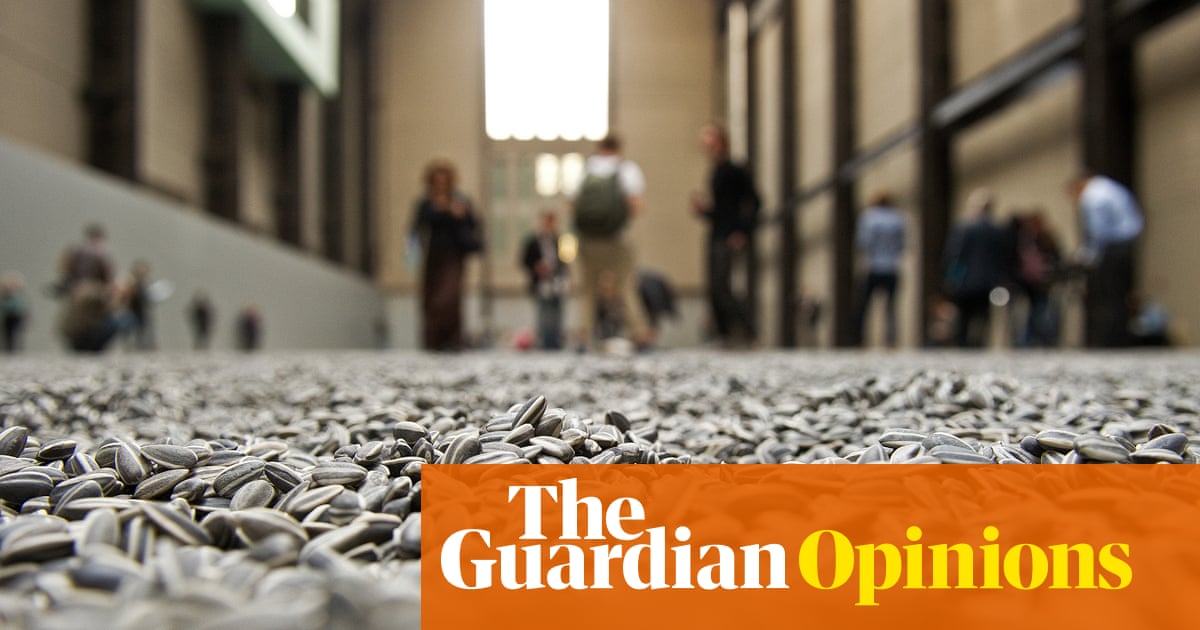We all respect a classicist. So it’s hard not to be impressed by Ian Hamilton Finlay’s learned citing of the Aeneid, Book X, on a stone column in this exhibition marking the centenary of his birth. The poet, artist and creator of Little Sparta – his renowned art garden – revived the neo-classical style at a time when artists were more likely to quote Warhol than Virgil. He appeals to anyone who’s sick of illiterate pop culture – a defiantly archaic figure who made no apology for his erudition.
Unfortunately, under the marble veneer, Finlay was an idiot. He flirted – more than flirted, claim some critics – with Nazi imagery, apparently fascinated by Panzer tanks and the SS logo. His fans insist it was all very nuanced but the Little Sparta website acknowledges “letters in which Finlay had made ‘anti-semitic’ remarks”. (Their quote marks on antisemitic, not mine.)

There are no Nazi images in this exhibition but Finlay’s interest in extremism and violence is unleashed in a series of bizarre and brutal conceptual artworks about the French Revolution. Marshall McLuhan’s maxim “the medium is the message” is incised on a panel of black slate. At first this looks like a witty transmutation of pop communication theory into engraved stone, but then you see the drawn outline of a guillotine blade: the “medium” Finlay’s celebrating is the slaughter of the Terror during the French Revolution, when first monarchs and aristocrats, then revolutionaries themselves, were decapitated in a bloody production line.
This is even more emphatic in a gnarled wooden reproduction of the block where a victim’s neck was held in place for the descending blade. It is inscribed “Le Revolution est un bloc” (“The Revolution is a bloc”) – a quote from the politician Georges Clemenceau in 1891, meaning the French Revolution had to be taken as a whole. Finlay, in a visual pun, changes its meaning: the Revolution requires bloodshed, he enthusiastically declares. To the block with them all. What adolescent stuff.
Candles on stools commemorate characters from the French Revolution including Robespierre, architect of the Terror. Marble reliefs pay homage to the revolutionary neo-classical artist Jacques-Louis David and his propaganda masterpiece The Death of Marat, a portrait of the revolutionary leader assassinated in his bath.
You may agree with Finlay that the Terror was a necessary purging, or an inevitable backlash, to reactionary attacks on the Revolution. The meaning of the French Revolution is still passionately debated, its history still being written. At least Finlay cares about history, a defender might say. So no, I’m not offended by his love of the guillotine. I am just saddened by the shallowness of an artist who, in his latter years, fumed in his garden about the need to wipe out the filthy aristocratic pigs instead of making art with any kind of universal human content. Superficiality is Finlay’s real sin. Artfully concealed behind the apparent weightiness of classical plinths and columns, his take on life lacks seriousness or depth. Someone who makes “provocative” Nazi references without apparently knowing what he meant by them is a fool not an intellectual.
after newsletter promotion

These Jacobin artworks were made in the wake of a controversy about his interest in the Third Reich. In the late 1980s Finlay was commissioned to create a sculpture garden at Versailles for the bicentenary of the French Revolution, but stories in the French press about his use of the SS logo, his correspondence with Hitler’s architect Albert Speer and the revelation of his apparently antisemitic remarks in letters led to him losing this prestigious job.
These artworks about the French Revolution were created in the 1990s in the wake of this humiliation. Perhaps his daft celebration of the guillotine is a longing for revenge. It certainly proves Versailles dodged a bullet, for these works are as crass as they are dry. They are not the art of a deep thinker or true poet.
Why does he get in these knots of pseudo-erudition instead of addressing profound themes? Looking at his classical works you might be reminded of the French artist Nicolas Poussin. But in Poussin’s most famous painting, Et in Arcadia Ego, shepherds puzzle over an inscription on a stone monument that translates as “I too am in Arcadia”, or maybe “I was also in Arcadia”. Latin is a richly terse language, the interpretation varies, but however you read it, this refers to death. There is death, even in Arcadia. It is universal.
Finlay completely lacks the sobriety and truth of Poussin. We all die, by the guillotine or some other way. Rhetorically raving about the glories of Jacobin violence is the opposite of the melancholy insights of great art. On this evidence, Finlay’s works won’t last another century.

.png) 13 hours ago
6
13 hours ago
6













































